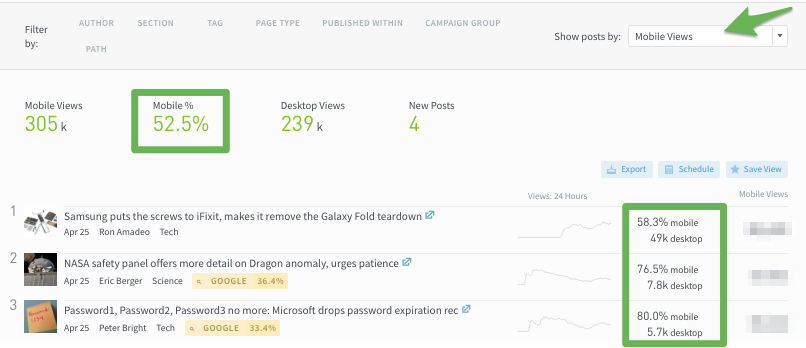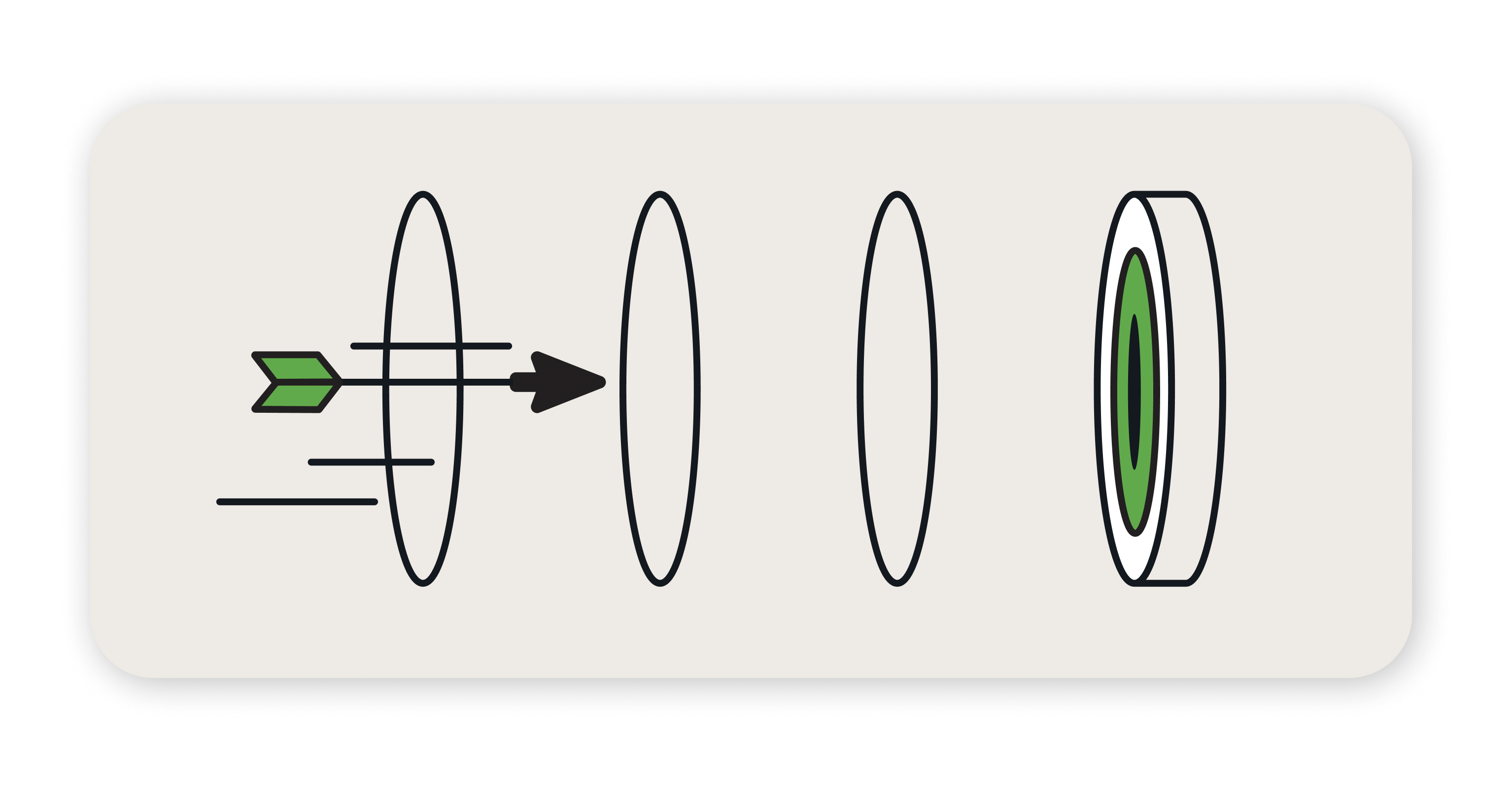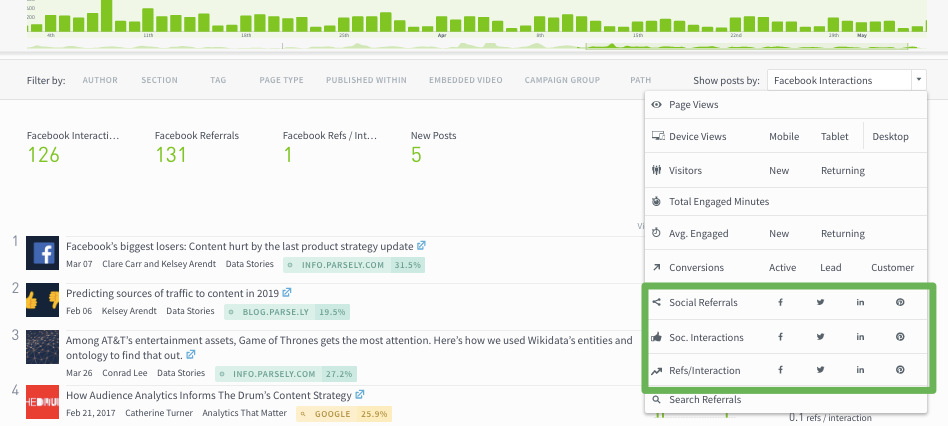The Most Important Metrics That Matter for Content

When you log into your analytics tool, you probably see things like exit rate percentage and traffic sources, scratch your head and wonder, “What do all of these mean? Which ones should I actually use to measure my content?”
It’s common to be overwhelmed by content analytics, so we compiled the most important web metrics and KPIs you should be tracking. We tell you what they do, how they’re calculated, and why they’re useful.
Important content metrics
- Traffic
- Engagement
- Conversions
- SEO and search performance
- Real-time data
- Social referrals and interactions
1. Traffic
Traffic metrics track the views and visitors to your site, identifying information about them. Direct traffic is typically the first information people look at, though it is surface-level data that doesn’t offer more than the effectiveness of a headline or preview of a given page.
There are three main metrics for traffic data: pageviews, visitors, and referrals.

Pageviews
Parse.ly identifies and tracks your site’s overall traffic in terms of page views, as well as a unique visitor count, which can be divided into “new” and “returning,” depending on the frequency of visits. Note: see a short history of the pageview, the oldest analytics metric out there.
Calculated automatically by most web analytics platforms, pageviews tell you the total number of pages viewed on your website. A single pageview is counted anytime a user’s browser loads a site page.
Pageviews measure how many people view individual pages on your site, giving you more insight into your overall website traffic. The more pageviews your site has, the more visibility your content gets.
Unfortunately, disreputable marketers have learned to distort or “game” this metric, from clickbait to bots. Savvy content providers, however, know that pageviews, gamed or not, don’t tell the whole story about a piece. Parse.ly shows pageviews as a measure of volume, but they’re always shown in context with other metrics. In Parse.ly, two built-in audience segments also use pageviews: views by mobile or desktop.

Visitors (new and returning)
The visitors metric looks at unique individuals that come to your site. The easiest way to think about the difference between pageviews and visitors: when a single user visits three pages, you have one visitor, but three pageviews. The ratio from visitors to pageviews indicates how many pages users look at on average.
Visitors can also be broken into two groups: new visitors and returning visitors. We separate these groups by checking to see if the visitor has been to your site in the previous 30 days. If they have, they qualify as “returning.” If not, they are “new.”
Similar to pageviews, total visitors still focuses on volume and reach. However, it is often more valuable for determining traffic because it equalizes content types. For example, a slideshow post may drive up pageviews compared to a single page, text-based post, because of the number of clicks and interaction it generates. But with visitor details, this discrepancy isn’t a problem.
If you are trying to reach a new audience, launch a new initiative, or grow your audience, measuring new visitors can indicate how successful you are. Alternatively, if you want to build audience habits or customer loyalty, make returning visitors your KPI to help you focus on what’s working for a specific segment.
Note: Visitor information can’t be exported and aggregated outside the Parse.ly dashboard. Unlike pageviews and engaged minutes, visitors can’t be rolled up and summed accurately on your own—you must rely on Parse.ly’s API to do this work.

2. Engagement
Each visitor is an opportunity to make an impression, capture a new lead, increase your brand’s reputation, or build a relationship with your audience. But if they aren’t spending time engaging with your content, it’s a lost opportunity. Engagement, which shows how deeply customers interact with your content, has traditionally been measured by different metrics.
Engaged time
Engaged time is the most meaningful engagement metric, more than just when a user opens a page and when they leave. It measures only the time when users are actively engaged with content (detecting cursor movement, scrolling, video playing, etc.).
Engaged time saves you time and effort by identifying content getting a lot of clicks, but not being read. If you’re writing 3,000-word articles but people engage with them for only 30 seconds, create shorter content that packs more of a punch. This can make for an effective measurement for certain content tagging strategies, including word count or content type.
Tip: Look at engaged time by topic in Parse.ly to better understand what topics drive the most engagement. Use this information to create more quality content on subjects audiences want to engage with.
“When we chose total engaged minutes, we had made a decision as a company that we wanted a driving metric that would help emphasize the loyal audience.”
—Julia Turner, former Editor in Chief, Slate
Recirculation rate
One of Parse.ly’s newest features, recirculation rate is an ideal indicator of which content is keeping your audience engaged on your site. Think of recirculation rate as the opposite of bounce rate. For example, if a post has 100 page views, and 45 of those page views lead to the user clicking on another piece of content on your site, it has a 45% recirculation rate.
If a page or post has a high recirculation rate, you know you’ve done a good job of guiding the reader to other relevant content, keeping them on your site longer. If the recirculation rate of a specific page is below your benchmark, add a recommended content block or an additional CTA to keep the visitor on your site.
Bounce rate
Bounce rate tells you the percentage of website visitors who view one page on your site before leaving (bouncing). This metric is calculated by taking the total number of one-page visits and dividing it by the total number of website entrances.
Generally, you want a low bounce rate, indicating people are engaging with your content. If your bounce rate is high, improve the page content. For example, add a CTA button to drive visitors deeper into the site.
But, not all bounce rates are created equal. Google Analytics categorizes a user who engages with a single page on your site as a bounce, whether they spend 10 seconds or 10 minutes there. In our view, someone who spends 10 minutes on one page is still a worthy visitor, which is why tracking engaged time and recirculation rate is more meaningful.
3. Conversions
Conversions measure how your content influences your readers to respond to the down-funnel calls-to-action on your site, providing a direct view into content ROI.
A conversion occurs when a desired goal has been met, such as a user making a purchase, signing up for a newsletter, or downloading an ebook. Your conversion rate tells you how frequently users carry out or reach the desired goal. It’s calculated by taking your total number of conversions, dividing it by your total number of sessions, and then multiplying by 100 to give you a percentage.
With Parse.ly Content Conversions, you get the full picture of how your content influences conversions. Parse.ly’s linear attribution model gives credit to every page viewed within 30 days of a conversion, mapping how individual pieces of content lead to revenue-related conversion events over time.

4. SEO and search performance
Anyone creating content does so with SEO in mind, which is why Parse.ly has multiple ways to identify how your content performs in search results.

Search referrals
Need to know which posts, topics, or writers bring in the most search traffic? Rank them by search referrals and recreate the strategies you used to generate those listed at the top. Having this 360 degree view of search performance is key to any content-driven SEO strategy.
Find and update pages that are already driving Google traffic. Make sure each includes links to relevant content and CTAs. Share stats and information with teams that run paid programs to increase ROI and click-through-rates on search ads.
Keyword ranking
Keyword ranking measures how your content ranks or places for a certain keyword or phrase when found through organic search. When a user types that phrase into a search engine, you want your content to appear high up in the results.
SEO and high keyword ranking help bring more traffic to your web pages.
Understand how well your keyword targeting is working by using Parse.ly’s search referral metric to see which topics drive the most visits from search engines.
Backlinks
Backlinks—links that point to your content from another website—bolster your content’s (and your company’s) authority in a particular field.
Authority ensures that users will seek out and trust your thought leadership, and means that your content is well-researched, well-informed, and useful. Building that authority is what keeps people coming back to your company for advice and knowledge, fostering a loyal audience. High authority rankings also improve your SEO and the results of your marketing campaigns.
Parse.ly can help here too. Use the referrer breakdown to see if certain sites drive significant traffic to your content. Find ways to get future content in front of them to recreate that success.
5. Real-time data
Aside from historical records, Parse.ly’s content dashboard provides support for many metrics that update in real-time through minute-by-minute, live-updating screens.
Analyzing content in real time, you can answer questions like:
- Which articles are trending right now?
- Which stories or topics are top-of-mind for my audience?
- What’s creating the most buzz on social media?
Real-time performance is especially important for media organizations, who rely on content to drive revenue.
At a glance, Parse.ly’s Top Posts report spotlights content with high and low pageviews, helping you optimize or amplify engagement on social media channels with added promotion.
6. Social referrals and interactions
For anyone focused on social media engagement, these metrics will be your go-to in the Parse.ly dashboard.
Social referrals
Social referrals show how much traffic, measured in pageviews, comes to your site from social media platforms, like Facebook, Twitter, and Pinterest.
Social interactions
The social interactions metric captures all off-site engagement for a select group of social networks (Facebook, Twitter, and Pinterest) Parse.ly officially supports through API integrations.
See interactions in total or broken down by platform. Facebook interactions include shares, comments, and likes. Twitter interactions include tweets, retweets, replies, and likes. Pinterest interactions include saves (pins) and comments.
These metrics are a powerful signal of organic, off-site sharing of your content. Monitor posts (or sections, or tags) for interactions throughout the day. Even if they aren’t driving much traffic yet, they can still indicate your content resonated with a socially active audience.

Referrals/interaction ratio
This ratio contextualizes how social referrals and social interactions metrics relate to one another. For example, in the image below, we see these posts shared on Facebook had 64 interactions (shares, comments, or likes) that drove 288 pageviews back to our site (referrals), a ratio of about 3.5 referral views per interaction. You might benchmark this ratio as “Facebook optimized,” delivering more than three clicks to your site for every share.z
This data can help you choose content to promote in Facebook page posting slots or whether to cross-promote the post in other platforms that behave similarly to Facebook (e.g., Twitter, Tumblr, or Reddit).
See the metrics in action
Watch the walkthrough video below to learn more about viewing these metrics in the Parse.ly dashboard.